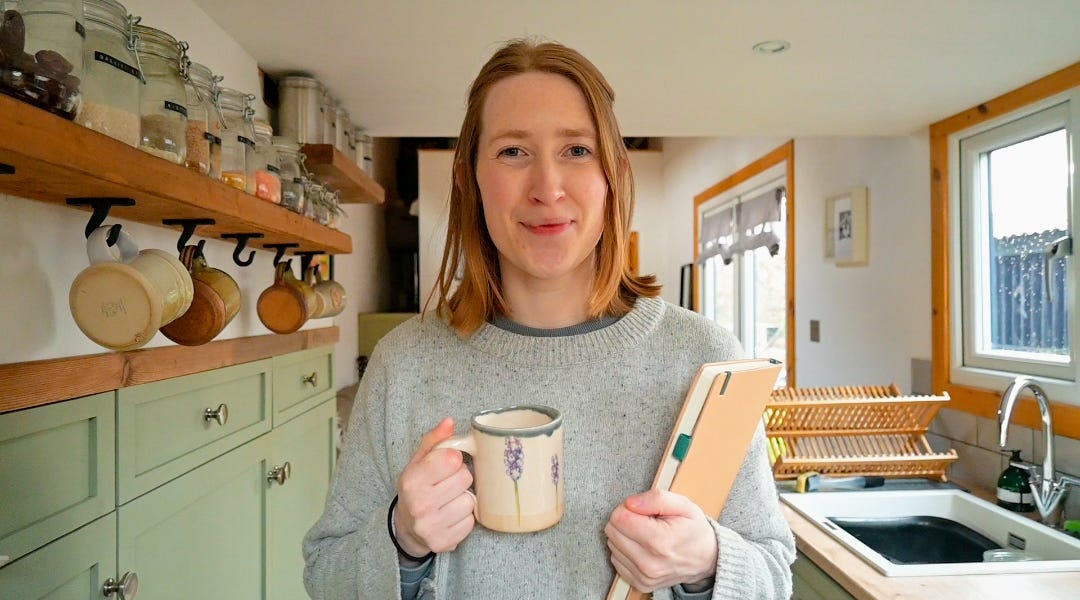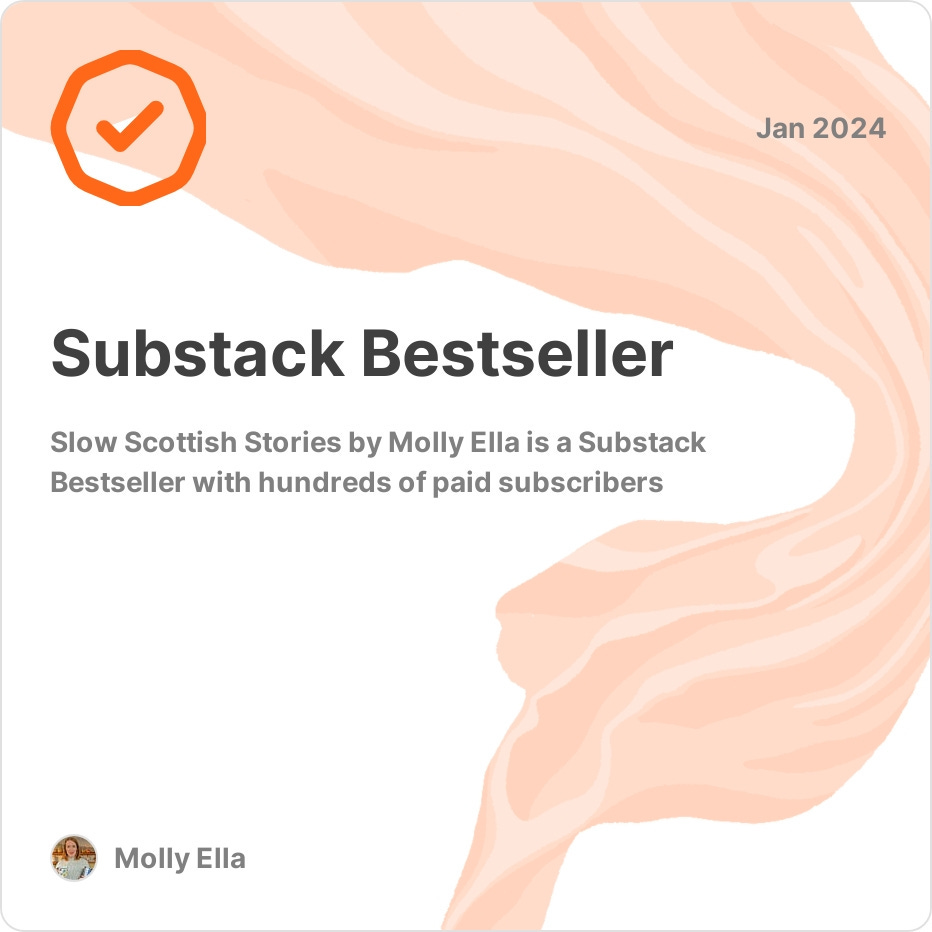How I became a Substack bestseller in under a month
An insight the strategy that changed everything
Hello, I’m Molly and I write about my slow and simple life in the Scottish Highlands.
Subscribe for free to enjoy occasional posts from me. Or, better yet, join our slow community of kindred spirits to unlock ALL my content, including exclusive writing, videos and resources, to help you live the life you REALLY crave.
We’d love you to join us for a cuppa…
It took 23 days for Slow Scottish Stories to become a Substack bestseller. In that time, I’d grown from 0 to over 100 paid members and counting. This is how I did it…
First, I need to provide some important context.
When I launched my paid membership, I already had an online community of over 45K subscribers between my YouTube and Substack. My Substack audience was a lot smaller than my YouTube following, but I still had over 3K free subscribers at the start of January.
I’ve been slowly growing my business since 2020 (ahem, lock down project) and I was finally able to make this my fulltime job in August 2023.
I’ve learnt a huge amount in this time about how to build a community and, crucially, a revenue online. I’ve refined my brand and content through lots of trial and error so that, by the time I opened my membership, I was in a strong position.
However, I genuinely never expected the response I got. In honesty, I had a secret goal of maybe 20-30 members in my first month, but I would have been happy with more than 0!
I’ve been overwhelmed with gratitude. All that hard work was finally paying off.
Once the shock of this milestone wore off, I started to reflect on exactly how I’d done this and, as I’m always keen to help out my fellow creators, I thought I’d share this with you today.
Of course, at the time of writing I’m only just over a month into my membership so its all very new, so this will just be a round up of my initial insights. Grab yourself a cuppa, I feel this is going to be a long one!
I made my membership my number one priority
Its no exaggeration for me to say that I have been mulling over the idea of starting a membership for over a year. In fact, its one of the main reasons I moved my writing from my blog to Substack in the first place.
However, I knew that if I wanted to do this, I wanted to do it right, which means that it had to become my priority.
This was a difficult decision as my YouTube was still thriving and continued to be my main income stream (read more about this HERE and HERE) and I knew that, by prioritising Substack, I would have less time to put into my YouTube videos.
It boiled down to my long-term goals. For me, writing is my first love. Its where my business started and its what I see in my future. Although I still enjoy and plan to continue with my YouTube, it was time to reassess and reprioritise.
I built up my free subscribers
By the time I launched my membership, I had already been writing on Substack for over a year where I have been consistently publishing on a weekly basis.
Not only that, but I had ensured that I’d put time and effort into improving my writing. This meant that I could ensure that all my content was of high-value and, naturally, my Substack subscribers started to grow as a result.
So I already had an invested audience and a quality portfolio that meant it was easier to persuade people to join my paid membership.
I’ve read on multiple occasion the advice that you should open a paid membership when you start your Substack. Although I see the value in this, as it allows writers the opportunity to earn money from the beginning, personally, I wanted to wait until I had a fully fledged strategy before launching a membership, which is what I’m going to move onto next.
I had a clear strategy
Importance of research
I’ve learnt throughout my creative career that, before I launch anything, it is so useful to do your research first. There is absolutely no point in putting time and effort into reinventing the wheel.
So, I reviewed all the Substacks I currently followed in a similar niche and made a note of what they were offering as part of there paid memberships, including signing up to a few myself.
This allowed me to recognise what worked well and provided inspiration on the type of content I could provide. Of course, it was never my intention to copy other creators but rather use this as a blueprint to work from, then add my own unique spin on things that allowed me to play to my strengths.
I also spent some time perusing the resources at
, which offer some fantastic advice on how to grow on here and I found their video masterclass, this post about converting free subscribers to paid, and this podcast with other successful creators especially useful.Paid vs free content
Before launching my membership, I wanted to be clear about what content was going to be free and what was going to be paid.
This took a lot of deliberation.
In the end, I decided to continue with my Monday posts, which would be a combination of free, paid or partially free with a paywall (more on this later).
In addition, I launched two new features that would be exclusively available for my members, which included my monthly tea time, where we go in depth into a particular topic, and my slow scroll, which is a round up of my monthly favourites.
This meant that there was a clear value added for my members, but I was still able to publish some high-value content that would help my publication grow.
Remain flexible
Having said all that, I still want to remain flexible with my membership.
This is a community space so I want to be able to adapt to best serve my members.
I’ve already asked for feedback (polls are great for this) and I will continue to do so.
As part of this, I regularly review all of my content as part of my business. I do this on a monthly basis and used my Blogger Notion Planner for my Substack (which is available on my Etsy store) so I can dig into my analytics before finalising the following months plan.
These reviews don’t take long and I’ve found this to be invaluable in ensuring that my content remains optimised for success.
I created an effective promotion plan
I started planning my promotion months before I launched my membership. This was split into two parts.
Launch promotion plan
This was content that I would release during the launch week of my membership.
This included rewriting my about page, my one-line description, my welcome emails and drafting an announcement post that I’ve pinned to my home page.
Again, I took time to do my research so I could see what worked well for other creators as well as refer to
resources, such as this post on creating an about/one line description and this one on crafting welcome emails.I also included a dedicated mention about my new membership on my YouTube during this week.
Long-term promotion plan
I’m all about never missing an opportunity to promote your work. This applied to my membership too.
This means that I’ve reworked my welcome blurb that I add to the beginning of every Substack post (see above) to include information about my membership. I also mention my membership regularly throughout my posts with a subscription button (see below).
Enjoying this post? To get even more content like this, you can sign up to my paid membership, and join our slow community of kindred spirits. We’d love to have you
I continue to mention my membership organically within my YouTube videos and always have the link in my description.
And, what I’ve found to be really effective, is that I am strategic with my paywalls.
For instance,
in this post I paywalled my detailed guide to a low buy year (generated 19 paid subs)
in this post I paywalled my nature memoir recommendations (9 paid subs)
for my slow scroll post, I included a summary of what this would include before adding my paywall to entice more sign ups (15 paid subs).
I also love that Substack has recently improved its video features and you can now add a paywall to show a snippet of a video, which I did in my January tea time (12 paid subs).
Simple but extremely effective.
I focused on community
This comes back to why I wanted to start my membership.
Yes, I wanted an additional revenue source and to concentrate more time on my writing. But I also wanted to create a nourishing space for like minded kindred spirits where we could all help each other flourish.
That’s why I resisted focusing on enticing lead magnets (e.g., like a free resource) and instead focused on creating content that would attract the right kind of people.
This also means that I regularly elicit meaningful conversations with my members (such as setting up this welcome thread) and always take the time to respond to their thoughtful comments.
I love seeing my members start to engage with each other and its my hope that this community will continue to thrive for a long time to come.
I’d love your feedback on this post, so let me know if you’d like to see more content like this. And of course please do share your own tips and advice in the comments.
Until next week,
Molly xx













Thank you for sharing all your knowledge.
I especially appreciated the links to the resources you used to upskill yourself and the examples of how you used to the payroll on your posts and how many paid subscribers it generated.
I know I will be referring back to this when I decide to go paid. 😊
While I can’t pay right now, I will tell you how much I appreciate that you will be responding to people’s comments. You won’t be able to respond to everyone but that is a powerful lure. I really want to read one of your nature memoir suggestions. I think the memoir called Freckled might interest you. It takes place in Hawaii mostly but a little bit in California. You might enjoy all the cultural and weather differences from your life in Scotland. Love what you are doing, keep going!